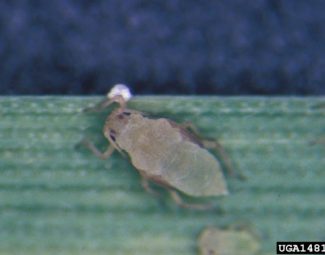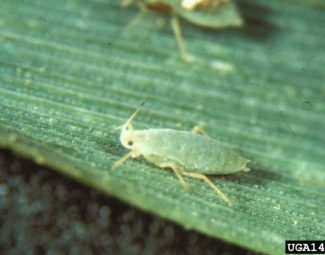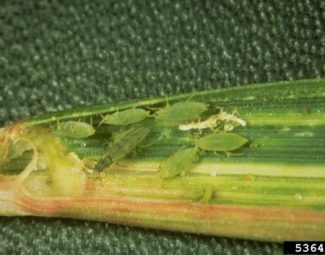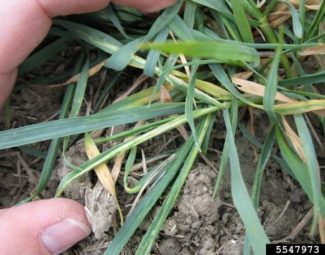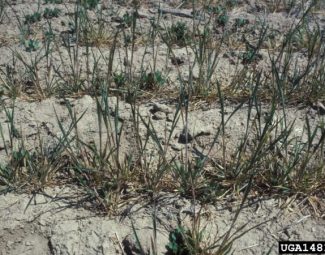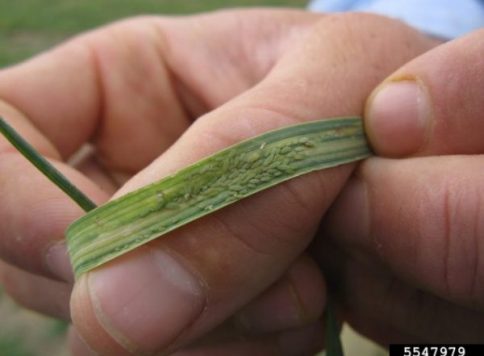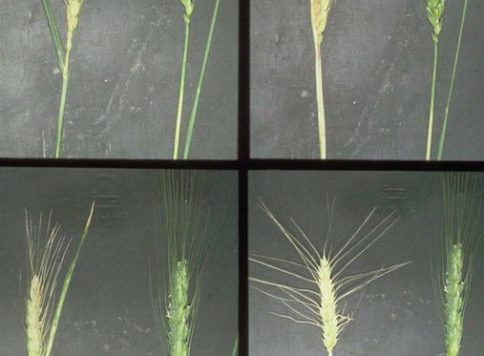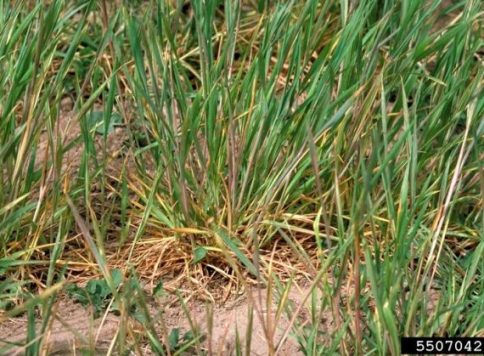Russian Wheat Aphid
Insect Summary Report
Diuraphis Noxia
General Information
- Distinguished from all other aphids by cigar-like, spindle shaped body and terminal end that appears to be split at the tip when viewed with a hand lens.
- In addition to extracting plant nutrients and excreting sticky sugar substance, this aphid also injects a salivary toxin that stunts growth, curls leaves and causes chlorotic and purple streaking. Infested flag leaf often results in hooked-shaped seed head.
- Wheat and barley most susceptible. Rye, triticale and oats more resistant to infestation effects. Does not infest corn, sorghum or rice.
- Often feed in the protection of curled leaves making contact insecticide use difficult.
- Non-crop grass hosts include: volunteer wheat, wheat grasses, bromegrass, native rye, and jointed goatgrass. Grama grass and pearl millet may also serve as alternate hosts.
- Not a vector of barely yellow dwarf virus.
- During sexual reproduction, females release a sex pheromone that attracts males.
Life Cycle (9-55 Days)
- Eggs… Produced by sexual reproduction.
- Nymphs… 4-5 molts. Green.
- Adults… Can produce as many as 5-6 live nymphs/day. Production slows dramatically as temps. approach freezing. Develop wings as crop and/or environmental conditions decline. Winged adults do not start reproducing until a new crop host is located.
Over-wintering Strategy
- Proposed Treatment Thresholds
- 2 Leaf – 5 per plant
- Early Tillering – 5 per tiller
- Late Tillering – 10 per tiller
- 1st Node – 10 per tiller
- Boot – 20 per tiller
- Head – 30 per tiller
Organic Control
- General Info
- Protective screens or plastic. Reflective plastic mulches have been shown to reduce aphid infestations.
- Augmentative releases of natural predators such as:
- Hippodamia convergens (Convergent ladybug)
- Parasitic wasps including Lysiphlebus testaceipe and Praon ssp.
- Chrysoperla carnea (lacewing)
- Orius tristicolor (minute pirate bug)
- Commonly Used Products
- Ferti-Neem Oil
- Ferti-Organics Karanja Oil
- Biorepel (Garlic Oil)
- Neemix 4.5 (Botanical)
- Ecotrol Plus (Rosemary and other essential oils)
- Soaps: Des-X
- Sil-Matrix
- Mycotrol ESO (Biological)
- BoteGHA ES (Biological)
Cultural Control
- Maintain good fertility, water moisture and mineral balance in plants. Identify macro- and micro- nutrient deficiencies by performing plant tissue and soil analysis. Adjust for deficiencies with foliar and soil applied applications of appropriate fertilizers.
- Destroy sources of native grasses that serve as refuges for re-infestation.
- Where possible, plant early to encourage seed head formation before aphid populations develop to a level that affects growth maturity and yield.
- Maintain uniform stands.
- Use high rates of control agents to avoid development of resistance.
More Images of the Russian Wheat Aphid
Bibliography
- Images by Frank Peairs, Colorado State University, Bugwood.org (damage to seedheads of wheat, collection of predators, alatoid nymph, alate adult, discolored tillers, imported pests, and colony on wheat leaf)
- Image by Phil Sloderbeck, Kansas State University, Bugwood.org (damage)
- Images by Mary Burrows, Montana State University, Bugwood.org (symptoms and russian wheat aphid on winter wheat)
- C. G. Summers, L. D. Godfrey, UC Davis/Kearney Agricultural Center, UC ANR Publication 3466. Feb. 2009. http://www.ipm.ucdavis.edu/PMG/r730300211.html (Damage, crop hosts, treatment thresholds, conventional controls, cultural control).
- J. P. Michaud and Phillip E. Sloderbeck, Kansas State University, Russian Wheat Aphid. May, 2005.

